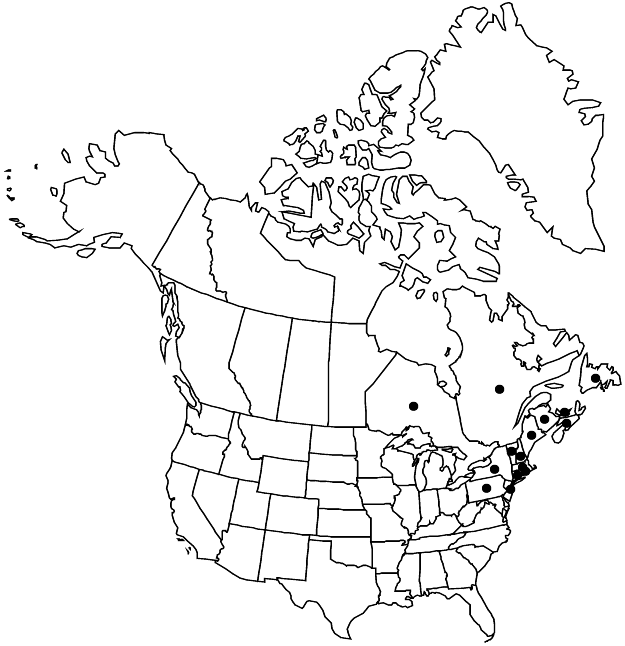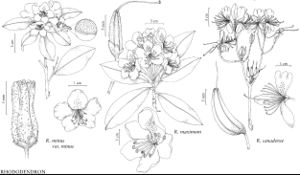Difference between revisions of "Rhododendron canadense"
in New York State, Rep. Geol. Surv., 151. 1841 ,.
FNA>Volume Importer |
imported>Volume Importer |
||
| (6 intermediate revisions by 2 users not shown) | |||
| Line 1: | Line 1: | ||
{{Treatment/ID | {{Treatment/ID | ||
|accepted_name=Rhododendron canadense | |accepted_name=Rhododendron canadense | ||
| − | |accepted_authority=(Linnaeus) Torrey | + | |accepted_authority=(Linnaeus) Torrey |
|publications={{Treatment/Publication | |publications={{Treatment/Publication | ||
|title=in New York State, Rep. Geol. Surv., | |title=in New York State, Rep. Geol. Surv., | ||
| Line 7: | Line 7: | ||
}} | }} | ||
|common_names=Rhodora | |common_names=Rhodora | ||
| − | |basionyms={{Treatment/ID/ | + | |special_status={{Treatment/ID/Special_status |
| + | |code=F | ||
| + | |label=Illustrated | ||
| + | }}{{Treatment/ID/Special_status | ||
| + | |code=E | ||
| + | |label=Endemic | ||
| + | }} | ||
| + | |basionyms={{Treatment/ID/Basionym | ||
|name=Rhodora canadensis | |name=Rhodora canadensis | ||
|authority=Linnaeus | |authority=Linnaeus | ||
| + | |rank=species | ||
| + | |publication_title=Sp. Pl. ed. | ||
| + | |publication_place=2, 1: 561. 1762 | ||
}} | }} | ||
|synonyms= | |synonyms= | ||
| Line 26: | Line 36: | ||
|elevation=0-1900 m | |elevation=0-1900 m | ||
|distribution=N.B.;Nfld. and Labr. (Nfld.);N.S.;Ont.;P.E.I.;Que.;Conn.;Maine;Mass.;N.H.;N.J.;N.Y.;Pa.;R.I.;Vt. | |distribution=N.B.;Nfld. and Labr. (Nfld.);N.S.;Ont.;P.E.I.;Que.;Conn.;Maine;Mass.;N.H.;N.J.;N.Y.;Pa.;R.I.;Vt. | ||
| − | |discussion=<p>Rhododendron canadense is distinctive and is most closely related to R. vaseyi; together they constitute sect. Rhodora (Linnaeus) G. Don (W. S. Judd and K. A. Kron 1995). Rhododendron canadense is sometimes cultivated for its showy flowers.</p> | + | |discussion=<p><i>Rhododendron canadense</i> is distinctive and is most closely related to <i>R. vaseyi</i>; together they constitute sect. Rhodora (Linnaeus) G. Don (W. S. Judd and K. A. Kron 1995). <i>Rhododendron canadense</i> is sometimes cultivated for its showy flowers.</p> |
|tables= | |tables= | ||
|references= | |references= | ||
| Line 35: | Line 45: | ||
-->{{#Taxon: | -->{{#Taxon: | ||
name=Rhododendron canadense | name=Rhododendron canadense | ||
| − | + | |authority=(Linnaeus) Torrey | |
| − | |authority=(Linnaeus) Torrey | ||
|rank=species | |rank=species | ||
|parent rank=genus | |parent rank=genus | ||
| Line 49: | Line 58: | ||
|publication title=in New York State, Rep. Geol. Surv., | |publication title=in New York State, Rep. Geol. Surv., | ||
|publication year= | |publication year= | ||
| − | |special status= | + | |special status=Illustrated;Endemic |
| − | |source xml=https:// | + | |source xml=https://bitbucket.org/aafc-mbb/fna-data-curation/src/2e0870ddd59836b60bcf96646a41e87ea5a5943a/coarse_grained_fna_xml/V8/V8_908.xml |
|subfamily=Ericaceae subfam. Ericoideae | |subfamily=Ericaceae subfam. Ericoideae | ||
|genus=Rhododendron | |genus=Rhododendron | ||
Latest revision as of 22:47, 5 November 2020
Shrubs, to 1 m, rhizomatous. Stems: bark ± smooth to slightly shredding; twigs sparsely multicellular eglandular- and shorter stipitate-glandular-hairy (hairs unbranched), also unicellular-hairy. Leaves deciduous; petiole multicellular eglandular- and stipitate-glandular-hairy and unicellular-hairy; blade elliptic to oblong or obovate, 1–8.3 × 0.4–3 cm, thin, membranous to chartaceous, margins entire, usually ± revolute, sometimes plane, eglandular- and unicellular-hairy, apex acute to rounded, abaxial surface eglandular- and stipitate-glandular-hairy, also unicellular-hairy, (± glaucous), adaxial surface scattered eglandular- and stipitate-glandular-hairy, also unicellular-hairy. Floral bud scales unicellular-hairy abaxially, and often stipitate-glandular- and eglandular-hairy, margins unicellular-hairy. Inflorescences sometimes fasciculate, 3–9-flowered; bracts similar to bud scales. Pedicels 3–10 mm, (usually glaucous), usually sparsely stipitate-glandular-hairy, and sometimes also densely unicellular-hairy. Flowers appearing before or, sometimes, with leaves, erect to horizontal, fragrant; calyx lobes 0.4–1.5 mm, often scattered stipitate-glandular-hairy, sometimes also unicellular-hairy, margins glandular- and/or eglandular-ciliate; corolla rose-purple to pink, rarely white, unspotted or red-spotted on upper 3 lobes, irregularly shaped, clearly 2-lipped due to very extensive connation of 3 upper lobes contrasting with 2 elongate, widely divergent lower lobes, 12–22 mm, glabrous or, sometimes, sparsely stipitate-glandular-hairy on outer surface, petals connate, upper lobe 3–8 mm, lateral lobes 12–22 mm (closely connate with upper lobe), lower lobes 12–22 mm, tube absent due to deep division between 2 lower lobes and between lateral and lower lobes; stamens 10, exserted, ± unequal, 9–20 mm. Capsules borne on erect pedicels, 0.7–1.7 × 0.3–0.6 mm, multicellular stipitate-glandular- and eglandular-hairy and densely unicellular-hairy. Seeds with flattened tails; testa tightly appressed. 2n = 52.
Phenology: Flowering spring.
Habitat: Moist to dry, coniferous or mixed conifer-deciduous forests, thickets, open rocky areas, lake margins, bogs, swamps
Elevation: 0-1900 m
Distribution

N.B., Nfld. and Labr. (Nfld.), N.S., Ont., P.E.I., Que., Conn., Maine, Mass., N.H., N.J., N.Y., Pa., R.I., Vt.
Discussion
Rhododendron canadense is distinctive and is most closely related to R. vaseyi; together they constitute sect. Rhodora (Linnaeus) G. Don (W. S. Judd and K. A. Kron 1995). Rhododendron canadense is sometimes cultivated for its showy flowers.
Selected References
None.
